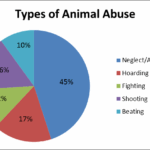In a world increasingly defined by ethical dilemmas, the issue of animal cruelty remains a persistently troubling specter that looms over society. The question arises—how many people, in a reflective moment, might implicitly endorse or tacitly accept such actions? This inquiry compels us to confront an uncomfortable truth: the nuances of human behavior often reveal a disheartening reality regarding support for practices that inflict suffering upon our fellow creatures.
To explore this accusation, we must first delineate the concept of animal cruelty. This term encompasses a broad spectrum of behaviors, from neglect and abandonment to overt acts of violence against animals. Individuals may unintentionally contribute to this crisis by endorsing industries that exploit animals for profit. Think for a moment: how often do we purchase products derived from animal suffering without reflecting on the consequences?
The hidden underbelly of animal exploitation often thrives in the shadows, perpetuated by a society that, on the surface, espouses compassion and care. Yet, statistics reveal a sobering contradiction. Surveys and studies consistently indicate that a significant portion of the populace may not fully comprehend the ramifications of their choices, or worse, may feel indifferent to them. What lies beneath this facade of ignorance and apathy?
An inherent challenge emerges from this juxtaposition of belief and behavior. Societal norms frequently dictate that animals are subordinate to human needs and desires. This hierarchical view can manifest in surprising ways. Consider the casual consumption of meat or the enjoyment of entertainment forms that involve animal performances. Each of these activities arguably reflects a societal complicity in the cruelty faced by animals, camouflaged beneath layers of tradition and habit.
Monitoring public sentiment toward animal welfare highlights an unsettling irony. A plethora of studies underscore vast support for animal rights; however, translating this belief into actionable behavior remains a daunting endeavor. For instance, while many express outrage over acts of cruelty, their purchasing habits may tell a far different story. The dissonance between opinion and action raises an essential question: Is the support for animal kindness merely a trend, or does it run deeper?
Alarmingly, a segment of society appears to exhibit a disinterest in the plight of animals. This lack of empathy can sometimes align with cultural, socioeconomic, or even regional factors. Certain communities, influenced by longstanding traditions, view animals primarily as commodities, which skews their perspective on animal rights. This intricate web of cultural conditioning influences perceptions of worth and value.
Moreover, misinformation and desensitization loom large in contemporary society. The images we encounter in media—be it through the glossy lens of advertising or the heart-wrenching footage of animal abuse—have the power to shape our views. Over time, repeated exposure to animal cruelty can lead to a numbness, an unwillingness to engage with the troubling truths behind what they consume. The nebulous line between awareness and apathy often distorts our collective moral compass.
In confronting animal cruelty, it’s crucial to parse the myriad forms it takes. Factory farming exemplifies the systemic nature of this issue. Those who advocate for reform risk ideological backlash; their endeavors are met with pushback from powerful agribusiness entities that prioritize profit over the wellbeing of sentient beings. This battle poses a significant dilemma for advocates who seek to educate the public about the realities of animal suffering. Their challenge lies not only in dismantling entrenched industries but also in reframing public consciousness.
With this in mind, how can one galvanize support for animals in a society steeped in apathy? The answer may lie in fostering authentic dialogues that inspire critical reflection. Encouraging individuals to ask challenging questions about their lifestyles can be a transformative process. Consider the impact of a community event centered around animal welfare that invites participants to share personal experiences. Such forums create opportunities for honest exchanges that can dismantle barriers to understanding, potentially shifting perspectives from indifference to advocacy.
Furthermore, implementing educational initiatives could disproportionately impact younger generations. By integrating animal welfare into school curricula, future generations may graduate with a heightened sense of empathy and responsibility. Imagine a world where sensitivity toward animal suffering is woven into the societal fabric, where compassion takes precedence over convenience and profit.
In conclusion, the uncomfortable truth about how many people support animal cruelty stems from a complex interplay of tradition, ignorance, and systemic exploitation. By illuminating these issues and challenging individuals to reconsider their roles in this narrative, we can foster a society that prioritizes the welfare of all sentient beings. The journey toward substantive change is intricate and fraught with obstacles, yet it is imperative for the sake of voiceless creatures everywhere. As we navigate this landscape, let us not shy away from confronting the uncomfortable truths that lie beneath the surface. The commitment to fostering a world free from animal cruelty requires unwavering resolve and collective action.






